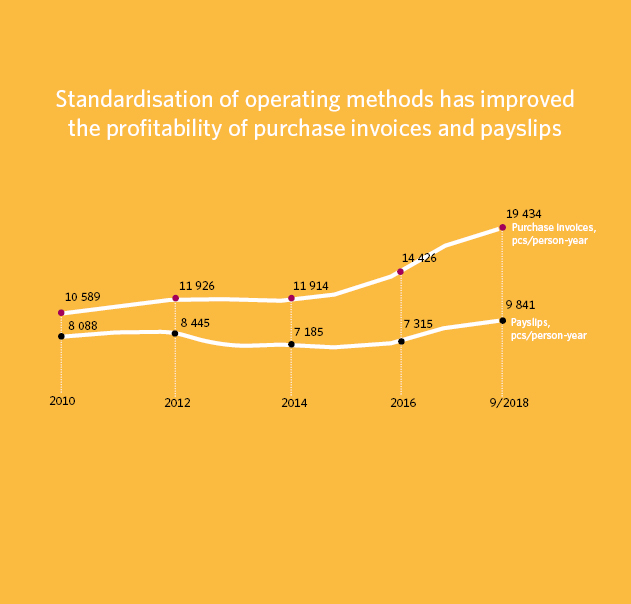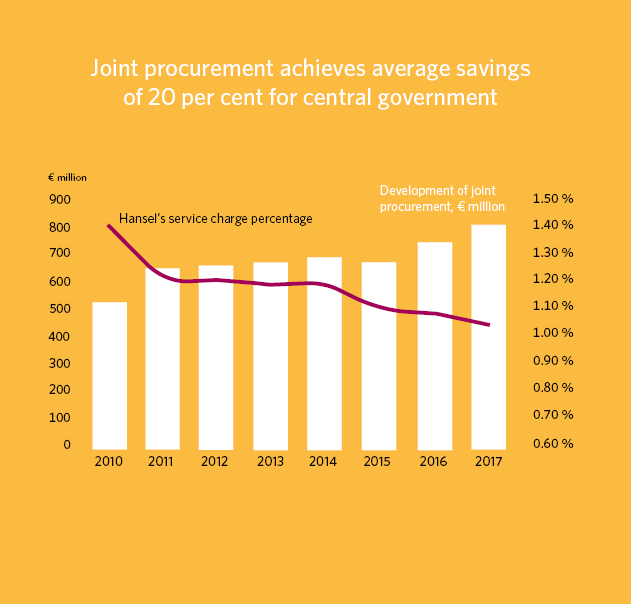In the early 2000s, the heading would have been considered Mission: Impossible, like in Hollywood. We accepted the task, however, and started to renew the support services and improve their profitability. Now that we are approaching the 2020s, it’s time to study the results. The support services have become versatile expert services that produce innovations and solutions for the everyday needs of their customers in addition to their basic duties. In the change of the central government structure, the providers of support services have been a vital resource in the development of the profitability of public administration.
Author: Tomi Hytönen, Budget Counsellor, Ministry of Finance
The parties that started the change of the central government support services were the Ministry of Finance, the State Treasury, Senate Properties, Hansel Ltd and Finnish Government Shared Services Centre for Finance and HR Palkeet. Together, they started to improve the profitability of procurement, property and facility management, and financial and HR administration by renewing the support services and operating methods. Ministries and their administrative sectors were closely involved in the change.
From scattered procurement to digitised joint procurement
At the turn of the millennium, government procurement was wasting its resources and struggled to maintain its expertise. Procurement was considered difficult and the shared services were unsatisfactory. The Ministry of Finance started to develop procurement to improve the situation.
Key means included a major increase in joint procurement, changing Hansel Ltd into the central government’s joint procurement unit and developing its services. A reform of procurement legislation and increased tendering competence requirements for public servants coincided with this change.
Hansel took on the task, and the result is efficient central government procurement and increased profitability, as Hansel’s tendering services offer public servants more time to take care of their other duties. Furthermore, the joint procurement created a foundation for efficient public procurement of volume goods and services.
The value of joint procurement increased from some €550 million in 2010 to some €830 million in 2017. Joint procurement provides the state with major savings (20% on average) in the form of reduced procurement prices and process expenses.
Image: Hansel’s service charge rate and the value of joint procurement between 2010 and 2017
The next major boost in procurement will be digitisation. Electronic tendering service Hanki was launched in the spring of 2016 and hard copy offers were abandoned. The tendering documents are available to anybody online, which makes the tendering more transparent and provides companies with more opportunities to participate in tendering processes. Tukihankintoja.fi service opened up central government procurement for all citizens and companies to see.
New facilities and working methods boost profitability
Organisations have their own traditions regarding facilities, and the development of facilities stirs up a lot of emotions. For a long time, central government facility management was considered a landlord and a rigid building manager. The financial pressures of the government agencies gave rise to criticism towards the expenses arising from facilities in the early 2010s. The agencies wanted to have functional and modern facilities, but they also wanted to achieve savings. That was a difficult task.
The government owns a large number of properties: 10,000 buildings in total, with a total surface area of six million square metres and total value of some €4.5 billion. The needs vary as well, and the annual property investments of central government are €230 million.
Senate Properties did not rest on its laurels to wait for the traditions to end in a tragedy wrought with problems with indoor air quality: it started to boost the use of the government properties and develop multifunctional office spaces. The development was speeded up by a reform of the services of Senate Properties, a facility policy of the Government and a reform of the rent system, which was started in 2015. As a result of it, central government has achieved savings of some €90 million per year.
An agreement on cumulative savings of more than €260 million by increasing efficient use of facilities has been made, and more than €190 million of these savings have already been achieved. The revenue from the sales of unused government properties amounts to almost €800 million. Centralised facility management continuously provides scaling benefits. For example, maintenance services can be purchased at a price that is 20 per cent lower than the price on the market, and investments in preventing indoor air problems can be simultaneously made. Facility planning and the management of costs are facilitated by comprehensive electronic facility data.
Central government has quickly adopted new working methods. Meanwhile, attitudes have also changed. This leads to an epiphany – a transfer to a multifunctional office space is never about renovating the facilities alone; instead, it is first and foremost a change of the working culture and daily working methods. These changes offer benefits and increase efficiency, as well as offer an opportunity for a major reform, as the change of the facilities also means a change of the working culture and daily working methods.
From Senate Properties, the enabling of the new working methods has required listening to the users of the facilities and understanding the factors that influence wellbeing at work, as well as determined development work, investments and tenacity. Nowadays, Senate Properties annually implements more than a hundred office environment development projects, and has developed a concept called Work 2.0 to support the work of knowledge workers.
The best rewards come from the users. They feel that they do more profitable work in a multifunctional office space. Surveys of government employees before and after a change of the work environment revealed that the employees felt that the change improved the profitability of their work by 13 per cent.

Image: Productivity of purchase invoices and payslips between 2010 and September 2018
Shared financial and HR administration operating model improved profitability
Central government financial and HR administration in Finland has gone through a major change, the likes of which have not been realised in many countries worldwide. Initially, each government agency had its own systems, own working methods and own service personnel. Plenty of optimisation was required, which meant that the profitability of the operations, which were highly similar, varied a great deal. For example, systems were renewed one piece at a time when technology improved.
In 2010, the Government decided that the working methods, processes and data systems in central government financial and HR administration would be standardised. Financial and HR services were centralised to a shared service centre, Finnish Government Shared Services Centre for Finance and HR Palkeet, and the State Treasury started the Kieku project to create a standardised financial, payroll and HR administration data system and standardised operating methods. Now, the operating methods in financial, payroll and HR administration throughout central government are highly similar and the agencies use the centralised services.
The improved profitability of central government financial and HR administration has mainly been seen as a reduced workload. When compared to the initial situation, the financial administration workload in Palkeet has been reduced by 31 per cent and the workload of the agencies by 15 per cent, and the HR workload of Palkeet has been reduced by 13 per cent and the HR workload of the agencies by 7 per cent.
Palkeet has been able to repeatedly improve the profitability of the processing of purchase invoices, sales invoices and payslips after the impact of the changed volume and the introduction of the shared data system (in 2012–2016). The standardised operating models in financial and HR administration have also improved the services of Palkeet.
Achievement of these benefits required determined work on the part of Palkeet and the agencies throughout the 2010s. It took time for the agencies to accept the new service centre, and Palkeet had to work to improve the quality of its services and keep its costs in check.
The agencies and Palkeet have accepted each other, and now the agencies want from Palkeet services that provide more added value. Palkeet offers its customers data analysis services. Furthermore, it has automated the operating processes of the agencies with the help of robotics (TPA services) and started an artificial intelligence project with Government ICT Centre Valtori. Palkeet and the central government financial and HR administration are at the forefront of the introduction of robotics. The extensive introduction of robotics would not have been possible without the standardised financial and HR administration system.
The change has not been completely voluntary. The development of the profitability of public administration requires determination, the ability to listen, freedom and control, and all of these must be balanced. The actions and their timing are often important and plenty of time is needed to realise the changes. The development of the central government support services can be used in future governmental reforms. As the work continues, it is time for an interim assessment: Mission: Possible!


